Marine Life & Conservation
Exploring with the Dive Ninjas: Diving with the Mobula Rays of Baja California, Mexico
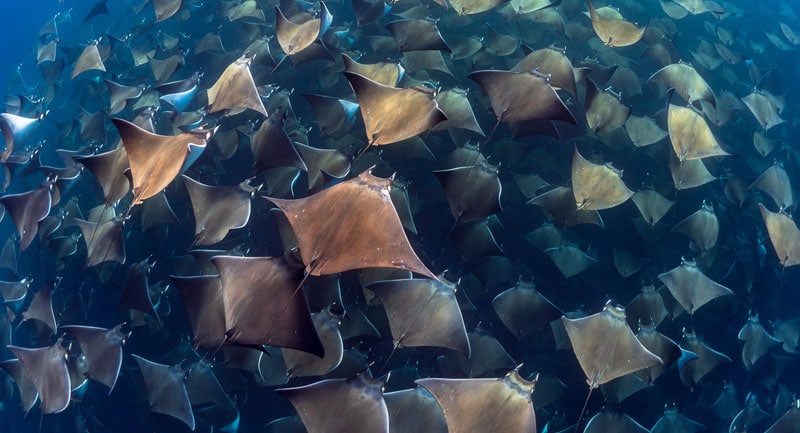
We are super excited to bring you the first in a new series of exclusive blogs for Scubaverse from Jay Clue, Founder of Dive Ninja Expeditions… Welcome Jay!
It’s dawn on the Sea of Cortez and the sun has just lifted above the horizon igniting the Baja sky and surrounding desert mountains with neon orange hues. As I scan the horizon, the silence on the water is almost deafening. Then it happens… A slap echoes across the sea. Then in quick succession another. And another. And another. It sounds like popcorn. Within seconds there are so many mobula rays leaping clean from the ocean’s surface that we struggle to even count them. We quickly grab our fins, masks and cameras, and get ready to jump in.
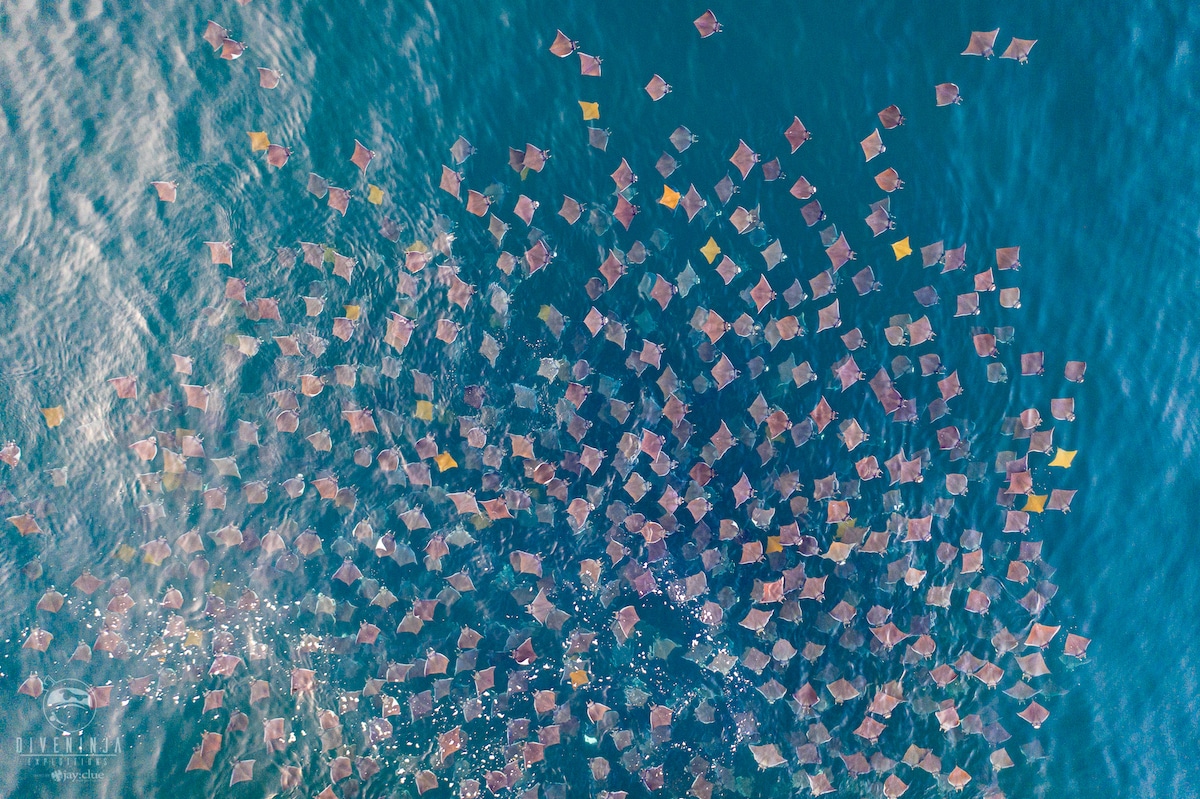
What comes next is something I struggle to put into words – no matter how many times I’ve seen it or try to speak about it. Imagine looking below the surface and your entire view is filled with a gigantic school of devil rays. Stretching from the ocean surface down to as far below as you can see. While white beams of light dance through the water the school swims in unison. It’s as if Mother Nature had choreographed thousands of beautiful underwater birds soaring together along a deep blue ocean backdrop. I’ve never seen anything else remotely close to it in the world. This is the annual mobula ray aggregation of Baja California Sur, Mexico.
The mobula rays of Baja California, or more specifically, Munk’s Devil Rays (Mobula munkiana, also known as Pygmy devil rays) live here year-round, but can also be found throughout the tropical eastern Pacific from Mexico to Peru. Usually they are found alone or in small groups. But every spring they begin to congregate in certain areas in southern Baja, creating what are considered to be the largest schools of any ray species on earth – and one of our planet’s most incredible natural spectacles. It is believed they gather here following the changing water temperatures to find mates and gorge on blooms of mysid shrimp and other zooplankton.
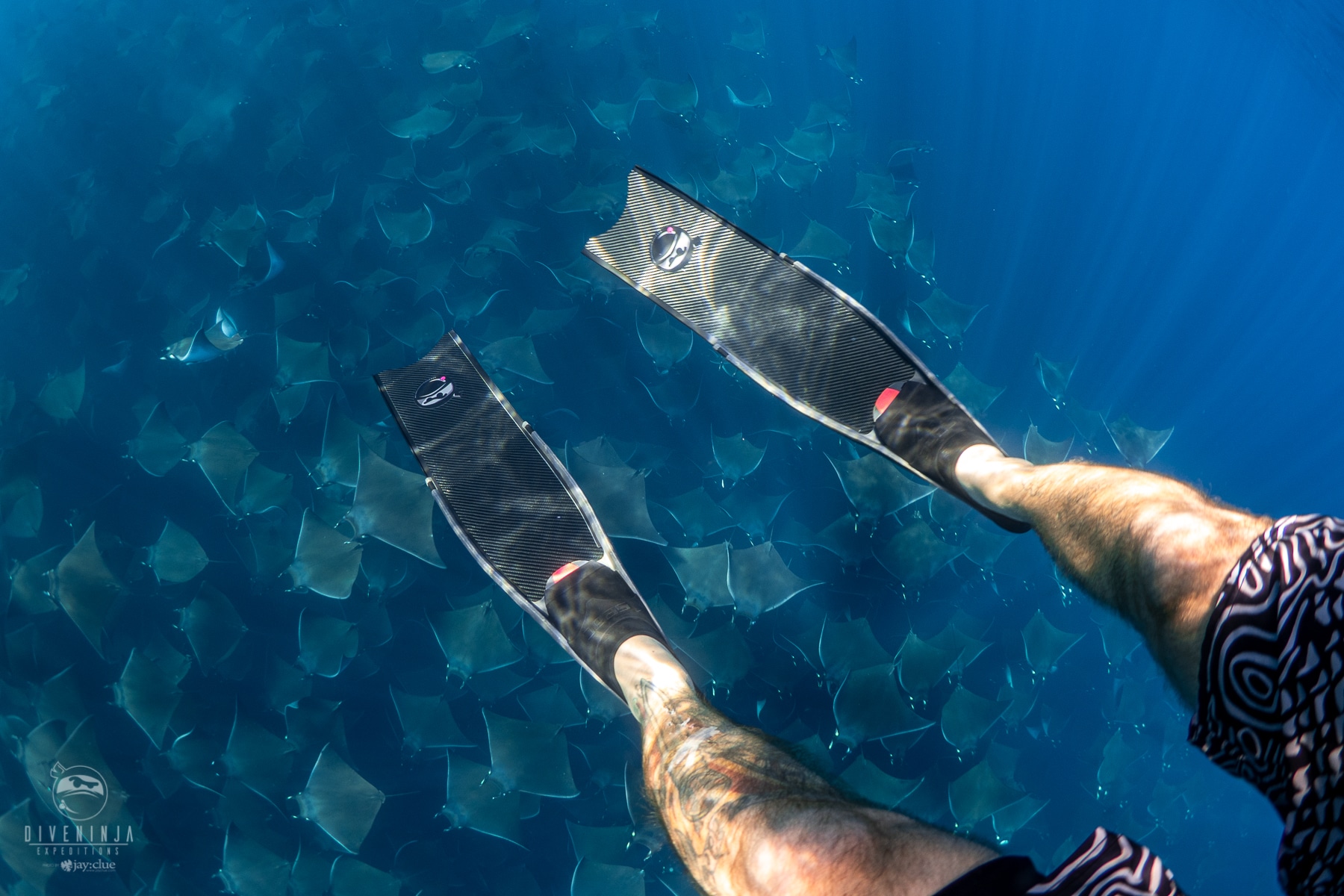
Although they create these gigantic schools every year not much is actually known about them. For example, we do not know how long they live for, or what their migration patterns are, or even why they love to jump from the water so much.

What we do know is that the IUCN has classified the Munk’s Devil Ray as Near Threatened since 2006. They also have one of the lowest fecundity rates (chance of reproducing) of any marine species due to them being estimated to only give birth to 1 pup every 2-3 years. This tied with them frequently being caught as bycatch in commercial fishing, gillnets, and by trawlers means their populations could easily take a sudden turn for the worse and diminish quite quickly. Scientists like Marta are working hard to better understand them so that more protections can be put in place to help preserve these elegant creatures and the natural wonder they create.
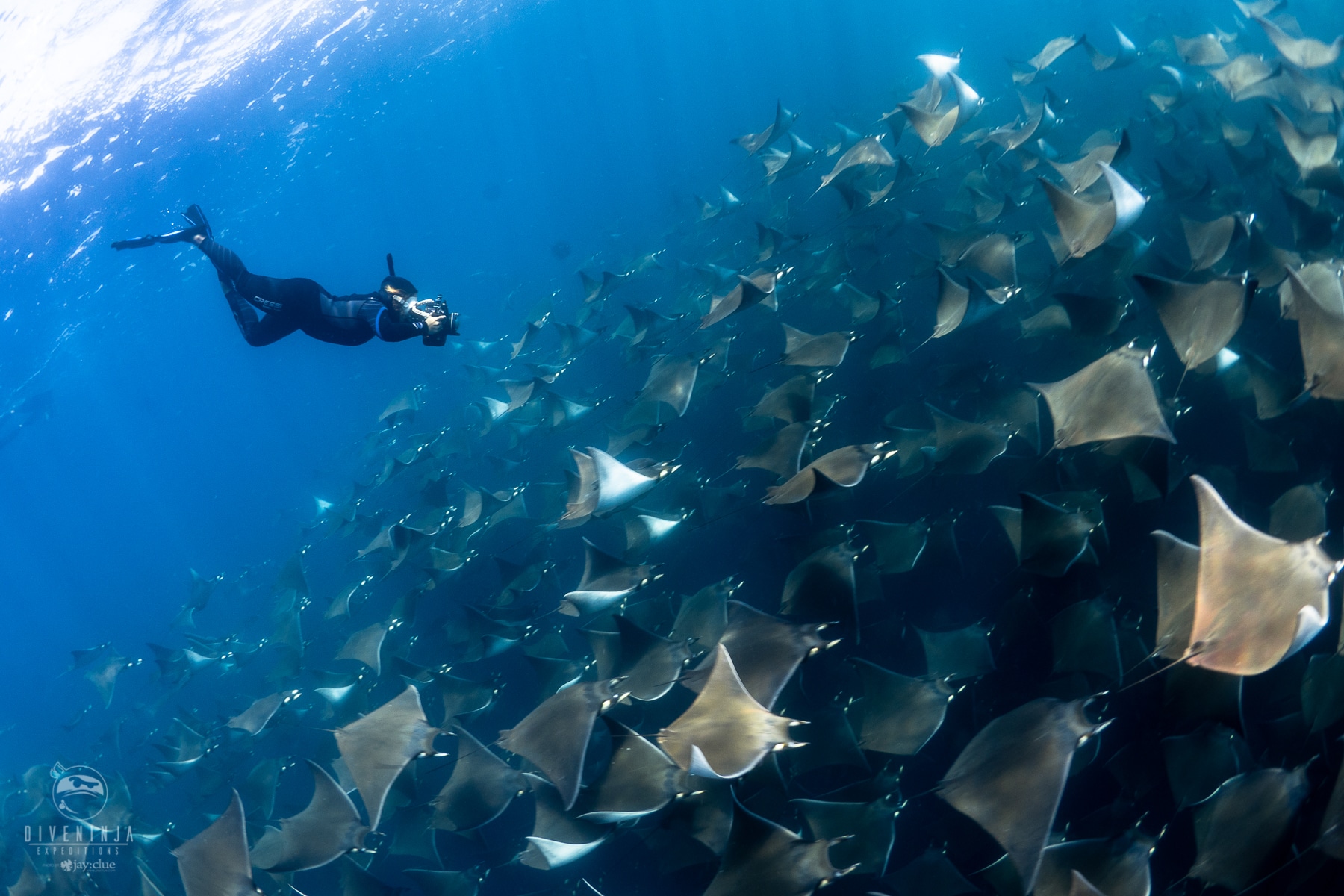
They are the smallest ray in the mobula family measuring about 1.1 meters from wing tip to wing tip – making them a fraction of the size of their huge cousins – the Oceanic Manta Ray. But what these little ninjas lack in physical size they make up for in acrobatic stunts. They are often seen flying from the water performing incredible flips and vertical jumps to heights of almost 3 meters above the surface – making for awesome encounters both above and under the water. Seeing the schools they create is an experience you will never forget. Diving alongside a school towering 20 meters tall and what seems like endless in length is jaw dropping. It is a stunning reminder of how remarkable our oceans truly are.
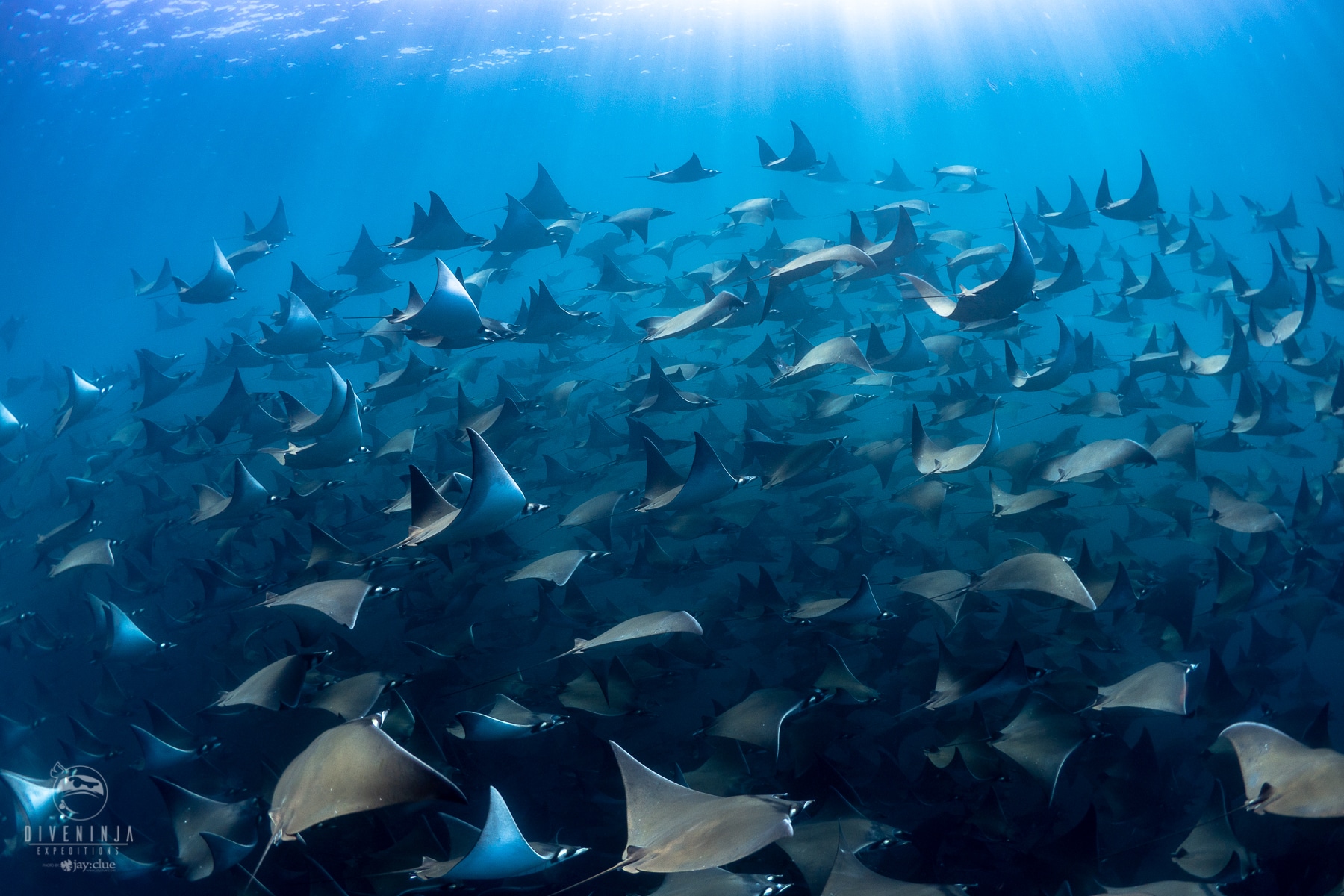
How to Experience it
The best time of year to see them is from late April until around mid July. Water temperatures this time of year can be a bit chilly around Baja, so you’ll def want to pack a wetsuit. But since all the action is within the first few meters of water, and the rays tend to stay away from bubbles, you can leave all the scuba gear at home and just pack your fins, mask, snorkel, and wetsuit. Flights are pretty straight forward with direct flights from many US cities, as well as Mexico City, into the Los Cabos International Airport (SJD).
There a few tour operators offering short half day tours to see them in La Paz and Cabo San Lucas. But for the best way to experience the magic of this event I would recommend planning for a few days with them because the action changes every day. Dive Ninja Expeditions runs specialized 5 and 8 day ‘Mobula Ray Expeditions’ to their ‘secret spots’ far away from the big cities and hoards of tourists. The expeditions are well thought out and include pretty much everything — oceanfront accommodation in a beautiful little beach town, round trip transfers from Cabo, educational talks & presentations, specialized Team Ninja guides, meals, and a lot more.
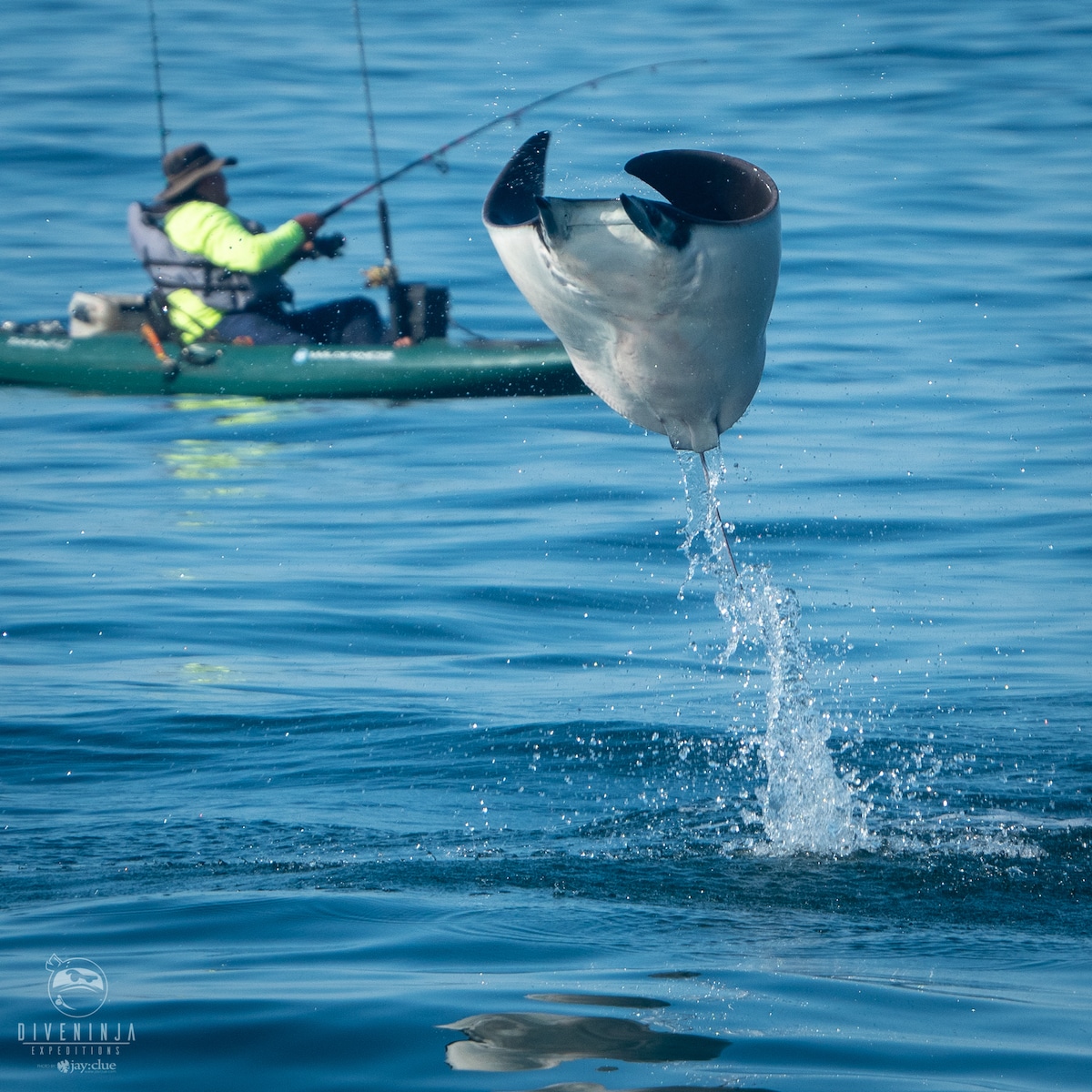
Additionally they offer citizen science style trips where the guests get to learn more about the rays and can take part in critical mobula ray research activities alongside marine scientist & mobula ray expert, Marta Palacios. Plus in proper eco-ninja fashion, a portion of your ticket purchase is donated by Dive Ninjas to help fund Marta’s research and local conservation efforts to protect these incredible creatures.
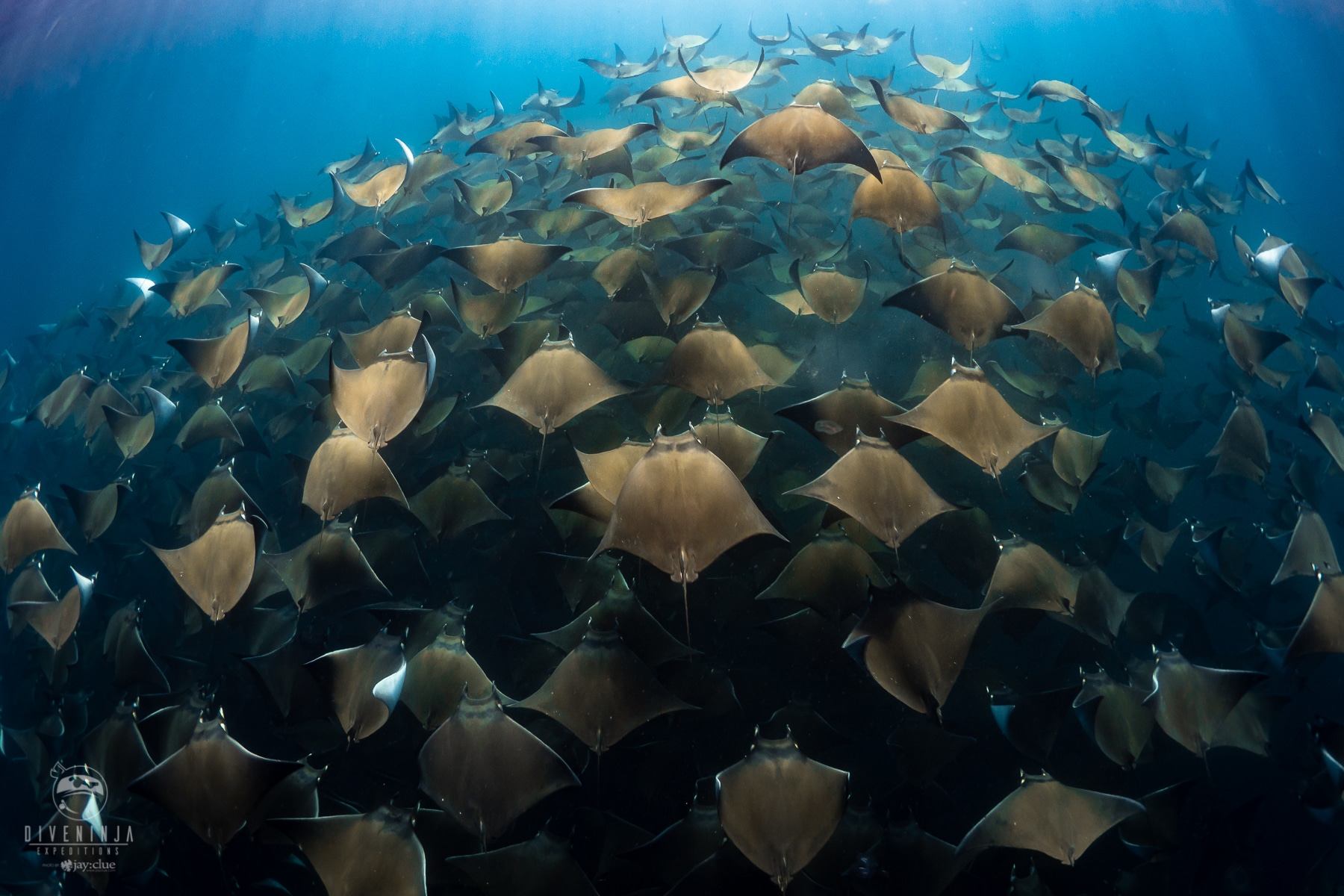
Interested in checking out this extraordinary adventure yourself? Visit the Dive Ninja Expeditions website, they’ve just released their 2020 Mobula Ray Expedition dates!
 For more from Jay Clue and Dive Ninja Expeditions, follow:
For more from Jay Clue and Dive Ninja Expeditions, follow:
Instagram: instagram.com/JayClue
Facebook: facebook.com/iamjayclue
Website: www.DiveNinjaExpeditions.com
Blogs
The Ocean Cleanup Breaks 10,000,000 KG Barrier

The Ocean Cleanup, the global non-profit project, has removed a verified all-time total of ten million kilograms (22 million lbs.) of trash from oceans and rivers around the world – approximately the same weight as the Eiffel Tower.
To complete its mission of ridding the oceans of plastic, The Ocean Cleanup uses a dual strategy: cleaning up the Great Pacific Garbage Patch (GPGP) to remove the plastic already afloat in the oceans, while stopping the flow of plastic from the world’s most polluting rivers.
Through cleaning operations in the GPGP and in rivers in eight countries, the cumulative total of trash removed has now surpassed ten million kilograms. This milestone demonstrates the acceleration of The Ocean Cleanup’s impact, while underlining the astonishing scale of the plastic pollution problem and the need for continued support and action.
While encouraging for the mission, this milestone is only a staging point: millions more tons of plastic still pollute our oceans and The Ocean Cleanup intends to continue learning, improving and innovating to solve this global catastrophe.
This announcement comes as governments from around the world meet to continue negotiations to develop a new legally binding instrument to end plastic pollution at INC4 in Ottawa, Canada. Representatives of The Ocean Cleanup will be in attendance and the organization will be urging decision-makers to collaborate towards a comprehensive and ambitious global treaty which addresses plastic at all stages of its life cycle and in all marine environments worldwide, including in areas beyond national jurisdiction.
It is encouraging to see that the need for remediation is reflected in the various options for potential treaty provisions. It is essential that the final treaty contains clear targets for the remediation of legacy plastic pollution, and reduction of riverine plastic emissions.
Tackling plastic pollution requires innovative and impactful solutions. The treaty should therefore incentivize the innovation ecosystem by fostering innovations that make maximal use of data, technology and scientific knowledge – such as those designed and deployed by The Ocean Cleanup.
‘After many tough years of trial and error, it’s amazing to see our work is starting to pay off – and I am proud of the team who has brought us to this point.’ said Boyan Slat, Founder and CEO of The Ocean Cleanup. ‘While we still have a long way to go, our recent successes fill us with renewed confidence that the oceans can be cleaned.’
The Ocean Cleanup was founded in 2013 and captured its first plastic in 2019, with the first confirmed catch in the GPGP coming soon after the deployment of Interceptor 001 in Jakarta, Indonesia. After surpassing one million kilograms of trash removed in early 2022, the non-profit project has since progressed to the third iteration of its GPGP cleaning solution, known as System 03, and a network of Interceptors currently covering rivers in eight countries, with more deployments set for 2024.
About The Ocean Cleanup
The Ocean Cleanup is an international non-profit organization that develops and scales technologies to rid the world’s oceans of plastic. They aim to achieve this goal through a dual strategy: stemming the inflow via rivers and cleaning up the legacy plastic that has already accumulated in the ocean. For the latter, The Ocean Cleanup develops large-scale systems to efficiently concentrate the plastic for periodic removal. This plastic is tracked and traced through DNV’s chain of custody model to certify claims of origin when recycling it into new products. To curb the tide via rivers, The Ocean Cleanup has developed Interceptor™ solutions to halt and extract riverine plastic before it reaches the ocean. Founded in 2013 by Boyan Slat, The Ocean Cleanup now employs a broadly multi-disciplined team of approximately 140. The foundation is headquartered in Rotterdam, the Netherlands.
For more information, visit: theoceancleanup.com and follow @theoceancleanup on social media.
Marine Life & Conservation
Steve Backshall to headline Shark Trust’s flagship event: For the Love of Sharks

Join a host of amazing, shark loving, speakers including Steve Backshall and the Shark Trust team for an evening celebrating shark conservation at the Royal Geographical Society in London this November.
Date: 29th November 2024
Time: 6-10pm
Location: Royal Geographical Society, London
Tickets: https://www.sharktrust.org/Event/flos24
The event will be a celebration of all things shark. Those lucky enough to get hold of tickets will hear from engaging guest speakers with a passion for sharks.
The line-up includes (*subject to change if unforeseen circumstances arise)
Steve Backshall: One of television’s busiest presenters, BAFTA award-winning wildlife expert Steve has been passionate about the wild world ever since he was young.
Steve’s impressive TV career has taken him all around the world, investigating a wide array of species and environments. Steve has filmed over 100 hours of children’s wildlife programmes with the BAFTA award winning Deadly 60 franchise and recently, with Sky Nature, for his new series ‘Whale with Steve Backshall’. He has been a patron for the Shark Trust for 10 years.
Simon Rogerson: is a photojournalist specialising in natural history, diving and the sea.
He is editor of SCUBA magazine, the official journal of the British Sub-Aqua Club. Simon started his career as a crime reporter but gravitated towards his ‘less depressing’ interest in underwater exploration, joining the staff of DIVE magazine in 1999. In 2005 he was named ‘Editor of the Year’ in the PPA’s Independent Publishing Awards. Simon also works as a freelance writer, contributing frequently to the Sunday Times and Telegraph, in addition to BBC Wildlife, Esquire, and a host of international diving magazines. He is the author of a book, Dive Red Sea, published by Ultimate Sports. Now based in Berkshire, Simon has been a Patron of the Shark Trust for 20 years.
More speakers to be announced soon. Head to the Shark Trust website to learn more.
The evening will also allow guests the final chance to see the Oceanic 31, shark art exhibition. Some of the artwork will be auctioned/raffled at the event, while the rest will be auctioned online to raise money for the Shark Trust Oceanic Programme.
For the Love of Sharks is an evening with something for everyone who is interested and fascinated by sharks. Join the Shark Trust, their Patrons, Trustees and Staff, along with a host of supporters for this celebration of shark conservation.
For more information or to buy a ticket: https://www.sharktrust.org/Event/flos24
-

 News3 months ago
News3 months agoCapturing Critters in Lembeh Underwater Photography Workshop 2024: Event Roundup
-

 Marine Life & Conservation Blogs3 months ago
Marine Life & Conservation Blogs3 months agoCreature Feature: Swell Sharks
-

 Blogs2 months ago
Blogs2 months agoMurex Resorts: Passport to Paradise!
-

 Gear Reviews4 weeks ago
Gear Reviews4 weeks agoGEAR REVIEW – Revolutionising Diving Comfort: The Sharkskin T2 Chillproof Suit
-

 Blogs3 months ago
Blogs3 months agoDiver Discovering Whale Skeletons Beneath Ice Judged World’s Best Underwater Photograph
-

 News3 months ago
News3 months agoPADI Teams Up with Wellness Brand Neuro to Drive Ocean Change and Create a Blue State of Mind
-

 Gear Reviews3 months ago
Gear Reviews3 months agoGear Review: Oceanic+ Dive Housing for iPhone
-

 News3 months ago
News3 months agoWorld’s Best Underwater Photographers Unveil Breathtaking Images at World Shootout 2023

















